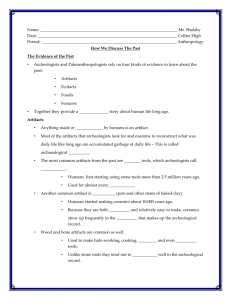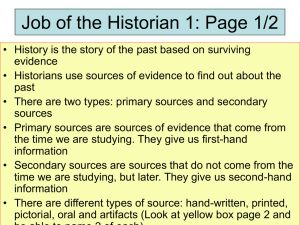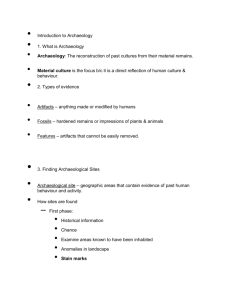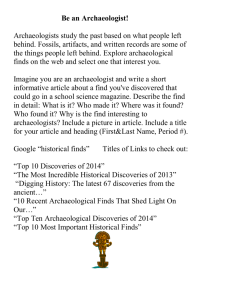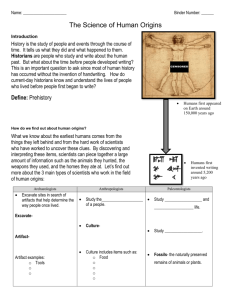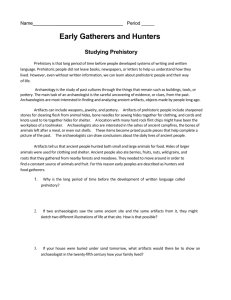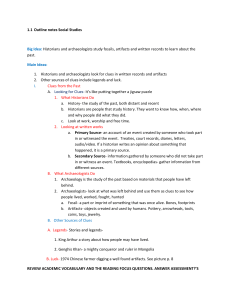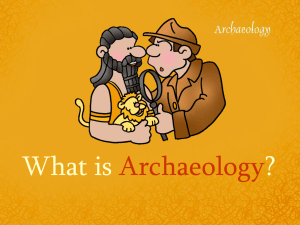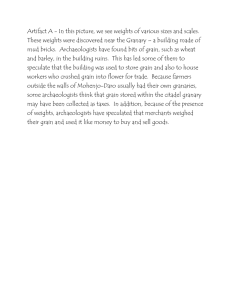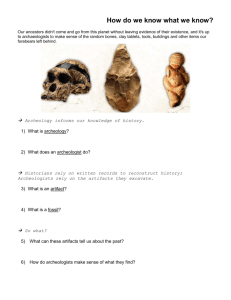Ch. 16 Archeology Vocabulary
advertisement
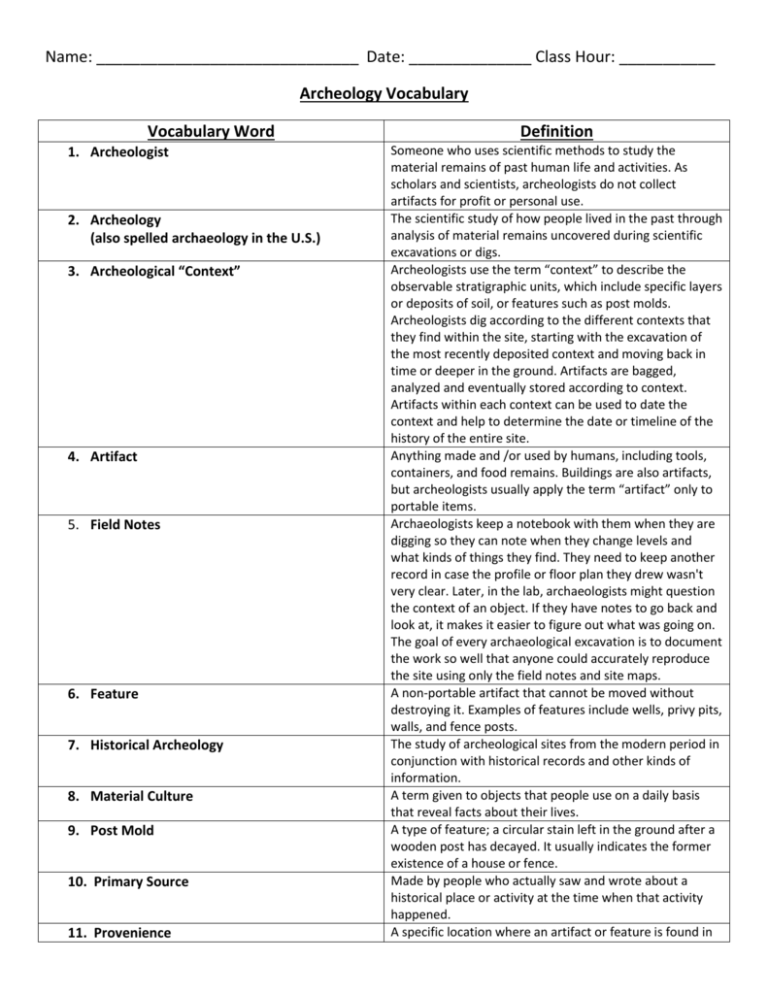
Name: ______________________________ Date: ______________ Class Hour: ___________ Archeology Vocabulary Vocabulary Word 1. Archeologist 2. Archeology (also spelled archaeology in the U.S.) 3. Archeological “Context” 4. Artifact 5. Field Notes 6. Feature 7. Historical Archeology 8. Material Culture 9. Post Mold 10. Primary Source 11. Provenience Definition Someone who uses scientific methods to study the material remains of past human life and activities. As scholars and scientists, archeologists do not collect artifacts for profit or personal use. The scientific study of how people lived in the past through analysis of material remains uncovered during scientific excavations or digs. Archeologists use the term “context” to describe the observable stratigraphic units, which include specific layers or deposits of soil, or features such as post molds. Archeologists dig according to the different contexts that they find within the site, starting with the excavation of the most recently deposited context and moving back in time or deeper in the ground. Artifacts are bagged, analyzed and eventually stored according to context. Artifacts within each context can be used to date the context and help to determine the date or timeline of the history of the entire site. Anything made and /or used by humans, including tools, containers, and food remains. Buildings are also artifacts, but archeologists usually apply the term “artifact” only to portable items. Archaeologists keep a notebook with them when they are digging so they can note when they change levels and what kinds of things they find. They need to keep another record in case the profile or floor plan they drew wasn't very clear. Later, in the lab, archaeologists might question the context of an object. If they have notes to go back and look at, it makes it easier to figure out what was going on. The goal of every archaeological excavation is to document the work so well that anyone could accurately reproduce the site using only the field notes and site maps. A non-portable artifact that cannot be moved without destroying it. Examples of features include wells, privy pits, walls, and fence posts. The study of archeological sites from the modern period in conjunction with historical records and other kinds of information. A term given to objects that people use on a daily basis that reveal facts about their lives. A type of feature; a circular stain left in the ground after a wooden post has decayed. It usually indicates the former existence of a house or fence. Made by people who actually saw and wrote about a historical place or activity at the time when that activity happened. A specific location where an artifact or feature is found in 12. Secondary Source 13. Stratigraphy 14. Urban Archeology 15. Absolute Dating also known as chronometric dating 16. A.D. 17. Archaeoastronomer 18. Attribute 19. B.C. 20. Chronology 21. Conservation 22. Dendochronology 23. digs 24. Ecofact the ground. Made by people who learned about the place of events from someone else or by looking at primary sources. Refers to the interpretation of the layers in archaeological deposits. By examining and analyzing the layers (strata) and the artifacts in them, archaeologists can learn how past people lived and what kinds of things they did. Usually, the artifacts found on top are the youngest (most recent), while those on the bottom are the oldest. If the stratigraphy gets mixed up (for example, if someone digs a hole down into it) then interpretation becomes much more difficult, and sometimes impossible. If this happens, artifacts are no longer in context. Urban archeology usually occurs when land is being cleared for new buildings or older buildings are being torn down. Archeologists are called to excavate the sites in order to collect and preserve the artifacts. This type of archeology is many times considered a rescue excavation because of the time pressure of the builders and construction crews. A dating method that attempts to determine an object's exact age (as opposed to its relative age) in calendar years (AD or BC/BCE) or in years before present (BP). This includes scientific methodologies such as dendrochronology, radiocarbon dating and potassiumargon dating. The dates provided by these methods are not 100% accurate, and each date has a margin of uncertainty. Abbreviation for the Latin phrase "Anno Domini," which means "in the year of our Lord." Used to refer to dates starting with the year 1 (i.e., this is the year A.D. 2003). Archaeologists who study how ancient peoples saw and thought about the planets, stars, and calendar. A characteristic or recognizable quality of an object, such as size, color, material, shape, age, etc., which is used to describe, analyze, or characterize an artifact. Abbreviation for "Before Christ.", used to refer to dates before the year 1. The arrangement of events in the order in which they took place. The scientific process of cleaning--and often repairing and/or restoring--an artifact in order to preserve it for further study and/or display. A method of dating that counts the annual tree rings and matches up the ring patterns to make a dating sequence, usually on wooden objects. The oldest form of scientific dating. Archaeological sites with on-going excavations A naturally produced object found on an archaeological site, such as the remains of animals or plants, that gives us information about past environments. For example, seeds, animal bones and soil could all be ecofacts. 25. Excavate/Excavation 26. Grid 27. Level 28. Midden 29. Observation 30. Paleoanthropologist 31. palaeontology/Paleontologist 32. Prehistory 33. Preserve 34. Profile The process of methodically uncovering and searching for remains of the past. Because an excavation removes any deposits, it destroys a site forever. Archaeological evidence is almost always destroyed if it isn't buried, so excavation plays a large part in recovering this evidence. Some excavation methods are grid layout, open excavation, and quadrant method. The division of an archaeological site into small squares that denote different areas of excavation, making it easier to measure and document the site. The layer in which archaeologists dig. When they dig down through many layers in one site, it is also a unit of measurement. All sites have different numbers of levels, and even the different units within one site may have different numbers of levels. How do archaeologists decide when they are going into another level? Archaeologists try to judge by cultural clues like floors, but sometimes they will go by changes in soil color or soil type, or even by a specific number of centimeters. For example, an archaeologist might give a different level number every 10 centimeters in a site. Archaeologists want to keep track of levels because this allows them to build a profile (or a cross section) of the units, so that they can look at how the site changed over time. A rubbish or trash heap of remains. At [ancient] settlements, a midden was the place where people discarded broken pots and tools, ashes, food remains, and other items that were thrown out or left behind. Because of this, middens are great places for archeologists to find out how people lived and what they cooked and made at a site. Looking at and critically noting the details of a site, an artifact, or cultural behavior. A type of anthropologist who studies early humans by excavating and looking at fossilized human skeletal remains. The study of fossils [/] the scientists who study these fossils. Human palaeontology is the study of human origins. The time before the development of written records; ends about 3,000 years ago. To keep safe and protect from injury, harm, or destruction; to keep alive, intact, or free from decay; to save from decomposition. A profile is a picture of the layers of a unit. It's sort of like if you were to make a five-layer cake with each cake layer a different color. If you looked at it from the side you would see all the different levels. This is very useful to archaeologists because they can see changes in soil color or composition (for example, sand and then black soil and then rock). A profile of a unit helps archaeologists understand the levels that were excavated, as well as changes in human activity over time. 35. Projectile Point 36. Replica 37. Restoration 38. Stratification 39. Underwater Archaeology 40. Unit Artifacts such as arrowheads and spearheads, used mostly for hunting animals. A copy or reproduction of the original The process of cleaning and studying an artifact and attempting to return it to its original form (before it was buried). Layers of deposits that provide archaeologists with one of the major tools or clues for interpreting archaeological sites (stratigraphy). Over time, debris and soil accumulate in layers. Color, texture, and contents may change with each layer. Archaeologists try to explain how each layer was added--if it occurred naturally, deliberately (garbage), or from the collapse of structures--and they record it in detailed drawings so others can follow. The process of excavating archaeological material covered by fresh or seawater. Archaeologists lay out a grid over a site to divide it into units, and then they figure out which units will be dug. Units vary in size. Archaeologists dig one unit at a time. Keeping track of specific measurements between artifacts and features gives archaeologists the ability to draw an overall map looking down on the site (called a floor plan), to get the bigger picture of the site.

